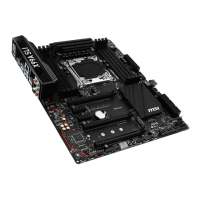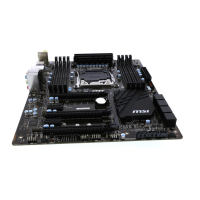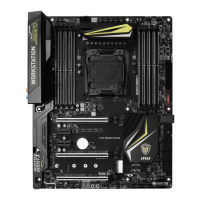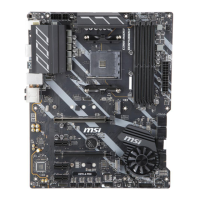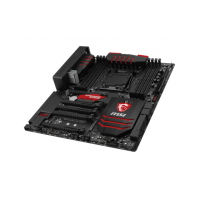
Do you have a question about the MSI X99S GAMING 9 AC and is the answer not in the manual?
| Socket | LGA 2011-3 |
|---|---|
| Chipset | Intel X99 |
| Form Factor | ATX |
| Memory Slots | 8 |
| Max Memory Support | 128GB |
| Memory Type | DDR4 |
| PCIe 3.0 x16 | 4 |
| PCIe x1 | 2 |
| SATA 6Gb/s | 10 |
| M.2 | 1 |
| SATA Express | 1 |
| Audio | Realtek ALC1150 |
| RAID Support | 0, 1, 5, 10 |
| Dimensions | 30.5 cm x 24.4 cm |
| USB 3.0 | 8 (4 on back panel, 4 via internal headers) |
| USB 2.0 | 6 (2 on back panel, 4 via internal headers) |
| LAN | Killer E2205 |
| Wi-Fi | 802.11ac |
| Memory Speed | DDR4-3300(OC)/3200(OC)/3000(OC)/2800(OC)/2666(OC)/2400(OC)/2133 |
| Multi-GPU Support | 4-Way SLI / 4-Way CrossFire |
Lists all items included in the motherboard package for user reference.
Important guidelines and safety measures for installing computer components.
Detailed technical specifications of the motherboard's chipset, memory, and slots.
Visual representation of motherboard architecture and component interconnections.
Quick reference for identifying and connecting various motherboard ports and headers.
Step-by-step instructions for installing the CPU and heatsink correctly.
Guide for installing DDR4 memory modules and understanding multi-channel configurations.
Procedures for mounting the motherboard in the case and connecting power supply.
Information on PCIe slots, bandwidth, and installing graphics cards.
Detailed information on various internal connectors like SATA, USB, and audio.
Explains the function of onboard buttons, switches, jumpers, and LEDs.
Process for installing essential software drivers for optimal system performance.
Visual guide for correctly installing the CPU and its heatsink.
Step-by-step instructions for installing RAM modules into motherboard slots.
Procedure for physically mounting the motherboard inside the computer chassis.
Guides for connecting power supply and SATA/M.2 storage devices.
Instructions for connecting front panel I/O, audio, USB, and other peripherals.
Detailed steps for installing a graphics card into the PCIe slot.
How to access and navigate the UEFI BIOS interface using mouse and keyboard.
Explanation of main BIOS categories like Settings, OC, M-FLASH, and Hardware Monitor.
Configuration of system date, time, SATA ports, and viewing system/DMI information.
Configuration of PCI, ACPI, peripherals, SATA modes, and USB settings.
Settings for power saving, OS compatibility, and boot behavior.
Setting passwords, trusted computing, chassis intrusion, and boot order.
Guides on CPU ratio, frequency, turbo boost, and OC Genie settings.
Configuration for DRAM frequency, timings, XMP profiles, and voltage adjustments.
Instructions for updating the motherboard BIOS using the M-FLASH utility.
How to save, load, and manage overclocking profiles for different system states.
Monitoring system temperatures, voltages, and controlling fan speeds.
Overview of the Realtek audio capabilities and DAC support.
Guide to configuring Realtek HD Audio Manager software and its interface.
Managing audio output sources, volume, and application enhancements.
Overview of Intel RAID controller, SATA features, and RAID levels.
Steps to create, delete, and reset RAID volumes using the Intel RAID Option ROM.
Procedures for handling degraded RAID arrays and rebuilding failed drives.
How to enable SSD caching for system performance using Intel RST.
Manual synchronization of data between SSD cache and hard disk for data loss prevention.


